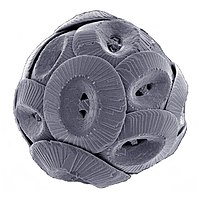
Photo from wikipedia
In this study, the amount of calcite precipitate resulting from microbially induced calcite precipitation (MICP) was estimated in order to determine the optimal conditions for precipitation. Two microbial species (Staphylococcus… Click to show full abstract
In this study, the amount of calcite precipitate resulting from microbially induced calcite precipitation (MICP) was estimated in order to determine the optimal conditions for precipitation. Two microbial species (Staphylococcus saprophyticus and Sporosarcina pasteurii) were tested by varying certain parameters such as (1) initial potential of hydrogen (pH) of urea-CaCl2 medium, (2) temperature during precipitation, and (3) the reaction duration. The pH values used for testing were 6, 7, 8, 9, and 10, the temperatures were 20, 30, 40, and 50 °C, and the reaction durations were 2, 3, and 4 days. Maximum calcite precipitation was observed at a pH of 7 and temperature of 30 °C. Most of the precipitation occurred within a reaction duration of 3 days. Under similar conditions, the amount of calcite precipitated by S. saprophyticus was estimated to be five times more than that by S. pasteurii. Both the species were sensitive to temperature; however, S. saprophyticus was less sensitive to pH and required a shorter reaction duration than S. pasteurii.
Journal Title: Applied Sciences
Year Published: 2018
Link to full text (if available)
Share on Social Media: Sign Up to like & get
recommendations!